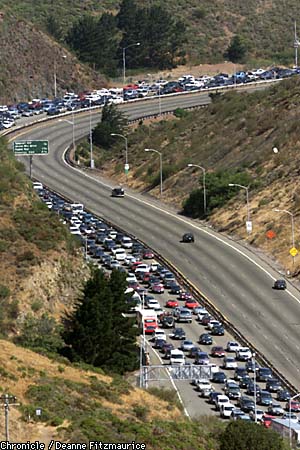Golden Gate span collision claims life
Barrier across bridge remains at study stage
Crews worked to
clear wreckage from a fatal head-on collision on the Golden Gate Bridge,
the scene of 15 such crashes since 1970.
Chronicle photo by
Deanne Fitzmaurice
A fatal head-on collision on the Golden
Gate Bridge produced a huge traffic backup.
San Francisco -- A head-on crash on the Golden Gate Bridge yesterday killed one driver and closed the span to traffic for nearly an hour, renewing debate over a 3-year- old plan to install a movable median barrier on the bridge. Authorities say the wreck occurred at 9:43 a.m. near the south tower when a Chevrolet Blazer heading south in the fast lane drifted into northbound traffic and slammed into a Ford Taurus.
The driver of the Blazer, a 60-year-old Crockett man whose name was not released, died three hours later at San Francisco General Hospital. The Taurus driver, 37-year-old Craig Meyers of Arlington, Va., suffered leg and ear injuries and was listed in fair condition. His passenger, Corey Gonzales, 32, suffered minor injuries. The couple were in the Bay Area on business.

The accident shut down the bridge for about an hour. The two southbound lanes were reopened at 10:33 a.m. and the four northbound lanes were opened just before 11 a.m. The crash brought new calls for the bridge district directors to install a median barrier that could be moved from one lane to another, depending on the number of lanes needed for commute traffic.
"It's obvious every time there is a head-on collision, there is a need for a barrier," said Robert M. Guernsey, Founder of "Citizens for a Safe Golden Gate Bridge," a San Anselmo inventor who first proposed the idea in 1996. "It will save lives and prevent head-on collisions."
The district agreed to study a proposed $7 million barrier in 1998, and has since been conducting engineering studies to test its safety and affect on traffic. Meanwhile, traffic fines have been doubled on the bridge and the CHP has stepped up enforcement. Officials said accidents on the bridge have been cut in half the last two years, from 50 a year to 25.
Since authorities started to keep statistics in 1970, there have 35 traffic deaths on the bridge, 15 involving head-on crashes. The median barrier being studied is a one-foot-wide steel wall that could be moved from lane to lane by a special truck. It would be narrower than the typical two-foot concrete barrier, yet would have to be strong enough not to give way if hit by a car.
A prototype has been built and crash-tested, but the district has budgeted no money to build it. The bigger problem, though, are the "technical and safety issues," said Denis Mulligan, bridge district engineer. One potential problem, bridge authorities say, is that any structure would narrow lane widths to less than 10 feet, increasing the risk of sideswipes and other accidents. The typical freeway lane is 12 feet wide.
Other problems are where to store the 50-foot-long "zipper truck" equipment needed to move the barrier on the bridge, and how to clear a path for tow trucks and emergency vehicles to cross the barrier to get to stalled or wrecked vehicles.
"We want to make sure that if we decide to move ahead with the movable median barrier, that we don't have unintended consequences that are worse than the problem we're trying to solve," said Karry Witt, the bridge district manager. Officials are awaiting the results of a second engineering study, due this fall, before deciding whether to move ahead.
"We're chipping away to getting answers to these things,"
Witt said. "We owe it to the 42 million vehicles that cross the
bridge each year to make sure that we have really, really studied this
thing."
Guernsey said, "The bridge district is dragging its feet and has no
interest in a barrier. I've tried everything possible," he
said. "There's no money in it for them -- it's out of their pockets,
with no return."
John Ehlen, a retired Bechtel engineer, has pledged $100,000 from his own foundation's money for the proposed barrier. He said 9 1/2-foot lanes have already proved successful on the Auckland Harbor bridge in New Zealand and elsewhere.
Ehlen is frustrated at the pace of the bridge district board to embrace the concept. "I'm an engineer," he said. "I'm not supposed to get angry."